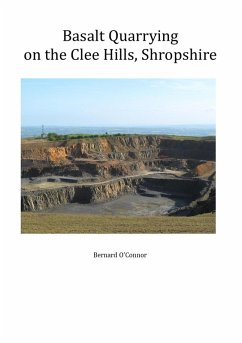Thomas Telford, the Scottish road and bridge builder, knew enough about rocks to recommend that particularly hard basalt found on the top of the Clee Hills in Shropshire would make a hard wearing and long lasting road material. The problem was extracting and transporting it. Railway engineers on the Shrewsbury to Ludlow railway successfully found investors and formed a company to construct a railway from Ludlow to Bitterley, a village just below Titterstone Clee. Geological surveys were undertaken and by 1867 an agreement had been signed with the landowner to open a quarry, labourers were employed to dig out the basalt and cut it into cobbles, the blocks used to pave roads, pavements, tramways, pedestrian areas, station forecourts, docks, wharves etc. An incline railway was constructed from Clee Hill on which trucks laden with stone were lowered to a goods yard at Bitterley and then transferred to the mainline to be sold in most metropolitan cities across England and Wales. Such were the profits to be made that, over the following decades, other companies were set up to exploit the basalt on the top of Titterstone Clee and Magpie Hill. A second incline and an aerial ropeway, the first of its kind, were constructed. The Cleobury Mortimer and Ditton Priors railway on the eastern side to the Clee Hills was needed to exploit the basalt on Abdon Clee and Clee Burf and a third incline installed. In the early 20th century massive reinforced concrete structures were erected on the hills to support the stone crushing equipment and concrete and asphalt works started in Ditton Priors. Thousands of men were employed, many migrating to the Clee Hills from other parts of Britain. As work in the quarries started early in the morning, the men had to walk, sometimes many miles, taking their breakfast with them. Houses, pubs, shops, churches and chapels were built, roads improved and services like water, sewage and electricity followed. Victorian engineers, entrepreneurs and landowners helped stimulate the local economy in ways never seen before. Bernard O'Connor's 'Basalt Quarrying on the Clee Hills' is a documentary history using contemporary sources, documents, maps, photographs, newspaper articles, geological papers, local histories and websites to provide a fascinating account of the geological, social, economic, archaeological and environmental impact of this industry which is still in existence more than 150 years later.
Dieser Download kann aus rechtlichen Gründen nur mit Rechnungsadresse in A, B, BG, CY, CZ, D, DK, EW, E, FIN, F, GR, HR, H, IRL, I, LT, L, LR, M, NL, PL, P, R, S, SLO, SK ausgeliefert werden.









